Here is our finished Imovie project, we never had chance to screen grab any progression :(
Wednesday, 13 April 2011
Question 9; Evalution
When we started planing for our filming we came up with an idea with an fair ground then we watched a previous film which gave me the idea of phobias. Then Rebecca and I came up with the idea of doing a place full of fears. Emily came up with the astonishing name for the film 'Fear Ground'. For the pitch we all produced the powerpoint presentation together. In regards to filming, Rebecca and I were the only ones who filmed, due to Emily being unable to attend.
By Annalise Potaczek-Gilzeane
By Annalise Potaczek-Gilzeane
Question 9: What was your contribution to the process during the planning, production and post production stages?
In the planning stage I feel I contributed quite a lot to our group decisions, our initial idea arose from current events as a fair was planned to be coming near us at the time of filming we all decided it would be a good idea if we filmed at the fair, but when the fair got cancelled we decided we would only include a clown and fortune teller. Also in the planning stages I wrote the script and helped the other members write the shot list, draw the test shots, storyboard and the film outline. Also when preparing our pitch we all created a slide each to present and talk to the rest of the class about, while doing this Emily came up with the name Fearground.
During the production stage I feel I contributed a lot to the filming of our piece, Annalise and I split the time we managed the camera equally meaning we both filmed about equal amounts. I also provided the location as the shoot was also held at my house and I bought in 2 actors to be in our film.
During the post production I feel a also helped a lot as I helped produce the music using the sorfware Garageband and the onscreen keyboard instrument and preset backing tracks. I also did a lot of editing as Annalise and I both split this equally to do as much editing each as we possibly could.
By Rebecca Foster.
During the production stage I feel I contributed a lot to the filming of our piece, Annalise and I split the time we managed the camera equally meaning we both filmed about equal amounts. I also provided the location as the shoot was also held at my house and I bought in 2 actors to be in our film.
During the post production I feel a also helped a lot as I helped produce the music using the sorfware Garageband and the onscreen keyboard instrument and preset backing tracks. I also did a lot of editing as Annalise and I both split this equally to do as much editing each as we possibly could.
By Rebecca Foster.
Question 8: Looking back at your preliminary task, what do you feel you have learnt in the progression from it to the full product?
From our preliminary task, I feel that we did use quite a range of shot types and angles but we had the posibility that we could of included more, also some of the clips we used lasted too long. When filming our final film we decided we would use as many different shot types and angles as we could, such as we experimented with canted angles on the stairs and the clown and also shot the same clips many times at different lengths to give as much variety in shots as possible. On the right is some examples of different shot types and angles from our preliminary film and on the left are some examples of different shot types and angles from 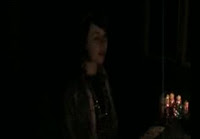
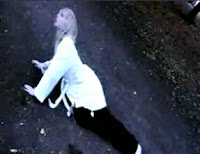
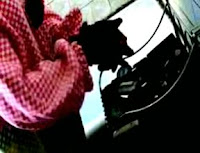
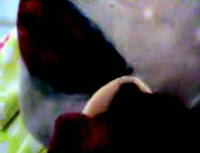
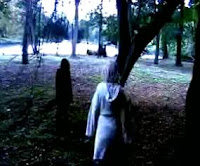 our final film including a midshot, a canted angle and an extreme close up. From the preliminary task, we learnt not to hold one shot for too long so we tried to keep the time of our clips to a minimum. Also from our preliminary we found how shakey the camera can be when not using a tripod so in our final film we used the tripod to hold a steady shot in as many places as possible. We also considered composition, in our preliminary task we thought we composed our shots quite well with the 9 grid guidelines on the camera so we decided we would use the grid to help compose our shots for the final film, we think because of this it helped the compostion in our final film. In our preliminary task we found it was quite bright which doesn't fit with the tyipcal conventions of a horror film, as dark settings are usually asscociated with horror, in our final horror film we decided we wanted the lighting to be a lot darker to fit these conventions. Overall, we have learnt how to compose a shot well and how to use a range of different shot types sucessfully to edit together well.
our final film including a midshot, a canted angle and an extreme close up. From the preliminary task, we learnt not to hold one shot for too long so we tried to keep the time of our clips to a minimum. Also from our preliminary we found how shakey the camera can be when not using a tripod so in our final film we used the tripod to hold a steady shot in as many places as possible. We also considered composition, in our preliminary task we thought we composed our shots quite well with the 9 grid guidelines on the camera so we decided we would use the grid to help compose our shots for the final film, we think because of this it helped the compostion in our final film. In our preliminary task we found it was quite bright which doesn't fit with the tyipcal conventions of a horror film, as dark settings are usually asscociated with horror, in our final horror film we decided we wanted the lighting to be a lot darker to fit these conventions. Overall, we have learnt how to compose a shot well and how to use a range of different shot types sucessfully to edit together well.
By Rebecca Foster.




 our final film including a midshot, a canted angle and an extreme close up. From the preliminary task, we learnt not to hold one shot for too long so we tried to keep the time of our clips to a minimum. Also from our preliminary we found how shakey the camera can be when not using a tripod so in our final film we used the tripod to hold a steady shot in as many places as possible. We also considered composition, in our preliminary task we thought we composed our shots quite well with the 9 grid guidelines on the camera so we decided we would use the grid to help compose our shots for the final film, we think because of this it helped the compostion in our final film. In our preliminary task we found it was quite bright which doesn't fit with the tyipcal conventions of a horror film, as dark settings are usually asscociated with horror, in our final horror film we decided we wanted the lighting to be a lot darker to fit these conventions. Overall, we have learnt how to compose a shot well and how to use a range of different shot types sucessfully to edit together well.
our final film including a midshot, a canted angle and an extreme close up. From the preliminary task, we learnt not to hold one shot for too long so we tried to keep the time of our clips to a minimum. Also from our preliminary we found how shakey the camera can be when not using a tripod so in our final film we used the tripod to hold a steady shot in as many places as possible. We also considered composition, in our preliminary task we thought we composed our shots quite well with the 9 grid guidelines on the camera so we decided we would use the grid to help compose our shots for the final film, we think because of this it helped the compostion in our final film. In our preliminary task we found it was quite bright which doesn't fit with the tyipcal conventions of a horror film, as dark settings are usually asscociated with horror, in our final horror film we decided we wanted the lighting to be a lot darker to fit these conventions. Overall, we have learnt how to compose a shot well and how to use a range of different shot types sucessfully to edit together well.By Rebecca Foster.
Question 7: What have you learnt about technologies from the process of constructing this product?
Some of the technologies we used to construst and update our film are Blogger, Imovie and Garageband. These all played a different but vital role in the production of our film, we used Imovie to construct the order of the clips we had filmed and also edit them by cutting them down to a suitable length, also to edit the brightness of some of the clips and to add some of the titles (the produced by). We used Garageband for the production of our music to be added to the film. We also used Blogger to keep updated about what we had been doing in lessons and throughout the week or what we planned to do in the week and to also add any inspiration that we found for our film. Because we had the access to these different technologies I think this gave us the chance to be more creative as we had not used any of these technologies before and it gave us a chance to use something new with new features, such as Garage band, this gave us the opportunity to create our own music using onscreen instruments and software like a keyboard. Also Imovie gave us the opportunity to use different effects and transitions to apply to our horror film. I also think having the access to these technologies gave us a lot more control over the structure of our piece as we got to create our own music to fit our genre and we were able to edit the clips to fit typical ideologies of the horror genre e.g. making it darker. We also used the internet the research target audiences and previous films and music for inspiration of our final film.
From making our film I have learnt that from how different technologies work together it is very effective in the production of films, I have also learnt how difficult and time consuming it is to produce a film from different technologies.
By Rebecca Foster.
Question 5: How did you attract/address your audience.
Our intended target audience was 15 - 24 year olds after showing our film to a few people in our target range we concluded that most common feedback we found was that lighting we used was very effective and the concept of the clown drew them in and they wanted to watch more. Everyone we showed the film to said they admired our music and helped add the suspense to our film, they also said it was very fitting to our genre and the themes of our film. The scene most people enjoyed watching was the ending scene as the clown is laughing, it added a lot of suspense and people wanted more to watch. They also like that there was a lot of close up shots not revealing the clowns identity. Because of this feedback we feel that has reached our target audience successfully, it had been more of a success than we thought because coming to the end everything was going wrong because we could never find a time for everyone to film but in the end we were able to pull through this. To target our target group we used actors of a similar age, and we included a phobia that many people of this age fear, we also included language that this age group would typically use and also the music was more modern to fit this age group. Through mise-en-scene we used locations that our target audience would hang around and feel safe in and turned them into something threatening.
By Annalise.
Question 6: What kind of media institution might distribute your media product and why?
The main British media company we have focused on was Hammer Films. This was because we have a monster in our film (the clown) and they are well-known for 'Dracula' and other such films involving supernatural beings. On the other hand, our film is focused more on the psychological side that those of Hammer Films, so we also researched Pinewood Films. They are a large British company, and we researched their films, and they are very successful. We feel that they would be the best direction for us. 

I believe that working with Hammer films would best benefit us with our clown costume and make-up. This is because of their well-known monster films and because the fear of clowns is one of the best known phobias. This combined with Pinewood Films would help make the film more psychological and realistic, and get our film around the globe! Mwah ha ha ha! WORLD DOMINATION IS MINE! This is because Pinewood Films is reputable and well-known. If we were to distribute our film, we would plan to show trailers on television after nine o'clock, and rated 15 in the cinema. We would also ensue that the ratings are clearly visible on all newspaper adverts. When releasing the film, we would start with the UK, and then maybe expand to the United States and other countries, provided the film was successful. Many British films are released in the same way, such as Slum Dog Millionaire by Film 4, another well-known film company.
By Annalise Potaczek-Gilzeane


I believe that working with Hammer films would best benefit us with our clown costume and make-up. This is because of their well-known monster films and because the fear of clowns is one of the best known phobias. This combined with Pinewood Films would help make the film more psychological and realistic, and get our film around the globe! Mwah ha ha ha! WORLD DOMINATION IS MINE! This is because Pinewood Films is reputable and well-known. If we were to distribute our film, we would plan to show trailers on television after nine o'clock, and rated 15 in the cinema. We would also ensue that the ratings are clearly visible on all newspaper adverts. When releasing the film, we would start with the UK, and then maybe expand to the United States and other countries, provided the film was successful. Many British films are released in the same way, such as Slum Dog Millionaire by Film 4, another well-known film company.
By Annalise Potaczek-Gilzeane
Question 4: How does your media product represent particular social groups?
The horror genre typically represents social groups by things such as age, gender and the stereotypes that apply to these groups as this will draw in their target audiences such as a film aimed at aged 15 - 18 year olds would include a younger cast around the age of that of the target audience. We applied these typical representations to our original idea as we planned to show a group of teenagers at a party as this is a typical stereotype for a group of teenagers, we also planned to show them going to a fair and this also adds to the stereotype. As we changed our original idea we applied these representations and stereotypes to our finished film by casting our actors around the same age of our target audience (aged 15 - 24) we used female characters as in horror films these are considered the most vulnerable and we set it in an area where teenagers would typically hang out and feel safe. We also represented another social group by the fortune teller, we had our actress dressed up in a patterned old robe with a scarf over her head, we also gave her jewellery such as old fashioned clip on earrings, a big ring and a number of bangles to give her a more creepy look. Some examples of what we were insipired by are shown by the pictures (taken from Final Destination 3) on the right above and below, the picture above insipred us for the look of our fortune teller with lots of jewellery and old looking clothing. The picture below is a good example for the typical representation of teenagers in a horror film as it shows a mixed group of teenagers at a fairground.
By Rebecca and Annalise.
By Rebecca and Annalise.
Question 2: In what ways does your media product use, develop or challenge forms and convetions of real media products?
Some of the forms and conventions of of the horror genre include focusing on turning safe things scary, using music to create tension in the audience, dark lighting, normally focusses on the victim as the main character, gore and violence are often used and are normally restricted and aren't very linear. We researched different films such as Steven King's IT in which conventions were used such as focusing on fears, dark shots were used, it was non-linear and restricted and the music was used to create the atmosphere. Also Final Destination 3 included conventions such as turning a fun place into a death trap, using dark lighting, it was restricted and linear and also had a lot of gore/violence incorporated into it. We used some of this research to make our horror film, this is important as it makes our film instantly identifyable as a horror and means the audience know more about it. We conformed to a lot of these convetions in order to make our film genre specific and to help us to create the right mood/atmosphere within our open sequence.
Here are some examples:
By Annalise Potaczek
Here are some examples:
By Annalise Potaczek
Question 1: Introduction: what did you make, who did you work with and where did the original idea come from?
As we were planning to make a horror film, so decided that we would look into other films, and determine just what it was that made them so scary. We soon realized that it was the placement of phobias into everyday life that did it. Somewhere you would have thought was safe was not!
We were inspired by two films, both of which demonstrated bringing peoples' fears to life. The two films were 'Final Destination 3' and 'It'. It was the featuring of a clown in 'It' that made us decide to use one as the main antagonist. 'Final Destination 3' features the title sequence as a fair ground, which is from which the title for our film 'Fear Ground' was derived.
The presence of the pin ball machine added to the tension, and ended with 'death'. Due to these, we decided to base our film on the idea of a 'fair of fears'. This is why we decided to to open the film in a house with a person putting on a clown costume, in fitting with the fairground theme (as we were unable to locate a fairground). After this, a black screen was shown with the words 'Fear Ground' upon it, and for the next scene we decided to feature teenagers in the room of a card reader, showing them tarot cards, and warning them not to leave.
When first shooting, the camera was out of focus in some places, so we had to reshoot some of the camera shots. Also, in one of the shots you can see the camera light in the window. Before we started filming, we asked the opinions of some members of our target audience of 15-24s. Whilst many thought the concept was a good idea, some were a little unsure about the clown being in the film, as they had coulrophobia, a fear of clowns. Because of this, we decided to include the clown in our film.
The people in our group were Rebecca, Emily and me amazing Annalise. At first we were all pumped up with our idea of filming at an real fair but we never had the chance due to harsh weather conditions. So after, we decided that we would film our horror film at Emily's house. but due to circumstances beyond our control (redecoration) Emily's house was out of bounds. So we decided to film at Rebecca's house the following day but Emily was unable to attend so we went ahead without her this also happened for the other two times we filmed. An big problem was that one of our members hardly turned up to lessons so we just had to edit the majority of the film.
By Annalise.
Screenshots from Garageband.
Here is the progression of our fortune teller music in Garageband for our horror film:
Here is our finished fortune teller music:
By rebecca
Thursday, 7 April 2011
Question 3: Who will be your target audience for your media product?


 The main target audience for a horror film is people aged between 15 - 26 both male and female, this varies on different films but most of the ratings are generally similar, I found this out by the statistics on the IMDB website, I decided to research on psychological films as this is the genre we were producing. Some examples of the reviews I found are from Paranormal Activity (2007) shown to the top right, which shows the that males and females equally enjoyed the film with the highest ratings coming from 'aged under 18' at an average of 6.6 and 'aged 18-29' at an average of 6.5. Another example I found is from Devil (2010) shown to the bottom right, which shows that males and females practically enjoyed the film equally but the main age group in which enjoyed the film was 'aged under 18' as this got the highest ratings at an average of 7.2. Our film will be aimed at this age range as it is the most successful. Originally we planned to make our horror film an 18 as this rating had less boundaries but after watching it back we decided to lower it to a 15 as it didn't fit many of the 18 boundaries, we also decided on the 15 rating because it is closer to our age range making it easier to understand what they will enjoy. After presenting the pitch to our class this had an influence our age certificate as the age range in the class is between 16 - 17 and the feedback we received was mostly positive so we decided to base the age certificate around these age ranges. This group of people is associated with horror films because their age range gives the highest ratings on the horror genre as shown on the photos displayed to the right. We have taken into consideration all this information found on IMDB to find a suitable audience for our film and came to the decision to make it a 15.
The main target audience for a horror film is people aged between 15 - 26 both male and female, this varies on different films but most of the ratings are generally similar, I found this out by the statistics on the IMDB website, I decided to research on psychological films as this is the genre we were producing. Some examples of the reviews I found are from Paranormal Activity (2007) shown to the top right, which shows the that males and females equally enjoyed the film with the highest ratings coming from 'aged under 18' at an average of 6.6 and 'aged 18-29' at an average of 6.5. Another example I found is from Devil (2010) shown to the bottom right, which shows that males and females practically enjoyed the film equally but the main age group in which enjoyed the film was 'aged under 18' as this got the highest ratings at an average of 7.2. Our film will be aimed at this age range as it is the most successful. Originally we planned to make our horror film an 18 as this rating had less boundaries but after watching it back we decided to lower it to a 15 as it didn't fit many of the 18 boundaries, we also decided on the 15 rating because it is closer to our age range making it easier to understand what they will enjoy. After presenting the pitch to our class this had an influence our age certificate as the age range in the class is between 16 - 17 and the feedback we received was mostly positive so we decided to base the age certificate around these age ranges. This group of people is associated with horror films because their age range gives the highest ratings on the horror genre as shown on the photos displayed to the right. We have taken into consideration all this information found on IMDB to find a suitable audience for our film and came to the decision to make it a 15.By Rebecca Foster
Subscribe to:
Comments (Atom)































